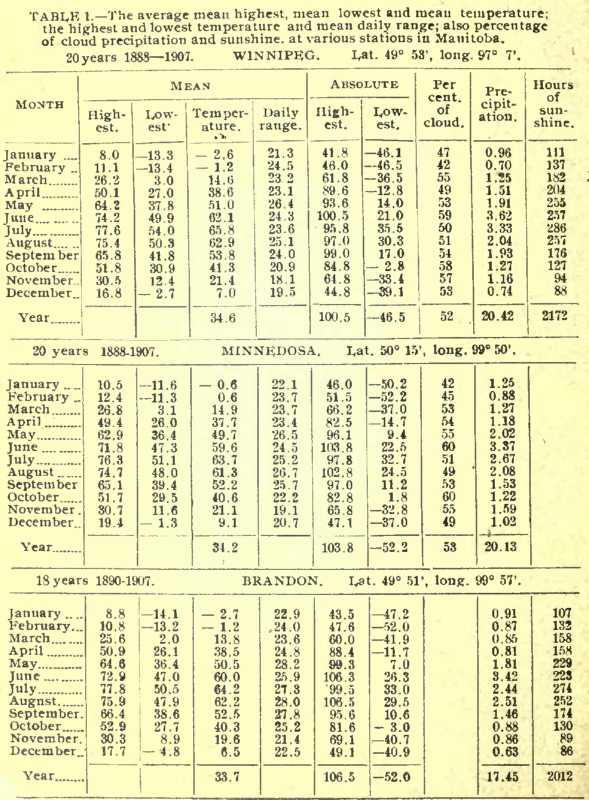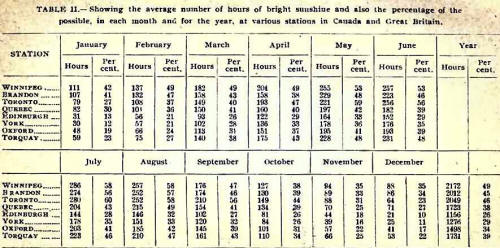|
THE Province of
Manitoba is almost in the centre of the continent, about midway between
the Atlantic and Pacific Oceans, and also midway between the Gulf of
Mexico and the Arctic Sea. It is many hundreds of miles distant from any
high mountains, and there are no important water areas to the westward.
The topographical features of the province are not pronounced. About
two-thirds of the total area, including the basins of Lakes Winnipeg and
Manitoba, are at a level of less than one thousand feet, while to the
westward the levels increase gradually to about sixteen hundred feet,
with some few districts a little higher. Its highest uplands are the
Porcupine lifts, between 52° and 53° N. (2,500ft.), the Duck Mountain
between 51° and 52° N., a portion of the Riding Mountain on about 51°
(2,000 ft.), and a portion of the Turtle Mt. immediately north of the
49th parallel (2,300 ft.). To the northward and north-eastward of the
province the levels fall away towards Hudson’s Bay.
Such being, in brief,
an outline of the geographical and topographical features of the
province, it is not surr pr'sing that the climate is typically
continental in its character and that such differences as exist between
different districts are due chiefly to latitude, and the general
meteorology of the zone within which the territory lies.
This one, within which
the other Western provinces are also situated, is one of peculiar
interest from a meteorological standpoint, inasmuch as the trajectories
of a large percentage of the cyclonic, areas moving across America lie
within it, and the passing of these disturbances causes some very abrupt
temperature changes. The fact also that the maxima of the winter mean
pressure is in some years to the northward and in other years to the
southward leads to very decided variability in the character of the
winter season in different years, some instances of which will be given.
The very pronounced
contrast between the continental and littoral type of climate is well
evidenced by the fact that the mean range in temperature between the
warmest and the coldest months of the year is 68° at Winnipeg, while it
is but 21° at Victoria, British Columbia. The absolute recorded range of
temperature at Winnipeg is 153°. A change of temperature of 49° in
twenty-four hours is not very exceptional in winter in Manitoba, and .a
range of 49= has been registered. Very pronounced also are the
departures from the normal in corresponding months in different years,
there being a January on record with the mean temperature 8° above
normal and another with the mean 13° below normal, and a February with a
mean temperature 25° above normal and also one with the mean 13° below
normal.
The monthly variations
from normal are not so pronounced in summer, the mean temperature of the
warmest July having been 70°.2 and of the coldest 008.6.
As will be obvious from
the figures just given, the change from winter to spring and summer is
more rapid than in Great Britain or Western Europe, and frequently an
April, which is wintry at the beginning, ends with conditions
approaching those of summer. An average April is not so warm a month in
Manitoba as it is in England. The season is not, however, so backward as
the monthly mean temperatures might seem to indicate. The daily range is
large, approximately 25°, and, while the nights are cold, the day
temperatures are high; the frost soon leaves the ground and the farmer
may commence sowing. The mean temperature of May is as high as in the
south of England, with the mean maximum considerably higher, and while
frosts occasionally occur they are seldom severe. Light snowfalls also
occasionally occur in this month, and at times are accompanied by high
winds, but these storms are seldom injurious to agriculture.
The rapid upward trend
of the temperature curve continues during June, the average daily
maximum of which month is 74° at Winnipeg and 72° at Minnedosa. Warm
days with frequent showers produce an almost phenomenally rapid growth,
which continues through July, for which month the mean temperature at
Winnipeg is 66°, with an average daily maximum of 78°. Few summers go by
without several heat spells, during which the temperature rises to 90°
or over, and in August, 1886, 103° was recorded in Winnipeg and 104° in
the more western districts.
August shews a
declining mean temperature after the middle of the month, and the last
fortnight is a period of uneasiness among farmers, as it is known that
in some years slight frosts have occurred, injuring such crops as were
not yet fully ripe. Summer is, however, by no means over, and periods of
exceedingly warm weather are not infrequent even in September; it is
only occasionally that there are night frosts in that month. October is
the true autumn month, during which the temperature curve begins its
most rapid decline; and before its close severe frosts are of nightly
occurrence, and on some days the temperature may not rise above the
freezing point.
The winter may be
regarded as of five months duration, viz , from November to the end of
March. It is not usually, however, until the last week in November that
the temperature falls to zero, and this occurs on a few days only, and
it is seldom that zero is registered after March 25th. January, with an
average mean temperature of —3*, is colder than February, but in both
these months there are generally long spells of exceedingly low
temperature, during which for days together the thermometer does not
rise above zero. As an example of this, in January, 1883, on twenty-two
days the temperature did not reach the zero point, and a minimum reading
of —46'’ was recorded. This was, however, exceptional and in marked
contrast to January, 1878, when there were only three days tin which the
temperature did not rise above zero, and minus readings were registered
on but twelve days The most exceptional winter month on record was
February, 1878, when the mean temperature was 24° and the temperature
fell below zero on but one day. In most years —40° is registered at
least once during the winter; —46° has been recorded four times, and
—50° was registered on December 24th, 1879.
The snowfall of
Manitoba ranges from 52 inches in the eastern districts to 44 inches in
the western districts, and while the ground is usually well covered from
December to March, it is seldom that the depth is great. In most winters
there are several heavy north-west gales succeeding the passage of
cyclonic areas, and in these storms, as the temperature drops quickly,
accompanied by a blinding drift of the dry snow, we have the well-known
blizzard of the prairies.
Winter in Manitoba and
in the Canadian West generally is not a season that is dreaded. It is,
on the contrary, a season which, with its bright, dry, exhilarating
atmosphere, is looked forward to with pleasure by most people. With the
cold weather, bright sunshine, extreme dryness and lack of precipitation
become the predominating features of the continental interior; 94 hours
of sunshine in November and 88 in December increase to 111 in January
and 137 in February. As with the increasing cold the humidity
diminishes, the electric spark between the body and any conductor bears
witness in a striking manner to the extreme dryness of the atmosphere.
The thin cirrostratus cloud which frequently overspreads the winter sky
when cyclonic areas are passing eastward across the western and
northwestern states is peculiarly productive of displays of parhelia
ranging from the ordinary “Mock Suns” to the mere intricate and
beautiful phenomena which at times include several circles and prismatic
colouring.
As might be expected
from the general similarity of the face of the country, there are no
wide differences in the monthly and annual amounts of precipitation in
the different parts of the Province; the mean annual amount for the
Province is about 19 inches, the heaviest, about 21 inches, occurring in
the extreme eastern portion, and the least about 17 inches in the more
southern and western districts. As, however, most of the precipitation,
especially the summer rainfall, comes from local storms, there is
sometimes a considerable difference in the amounts recorded at places
not far distant from each other. Between 9 and 10 inches of rain, or
approximately 50% of the total annual precipitation occurs between May
and August and is nearly equal to the amount that occurs during the same
period in Ontario and in the midland counties of England. At Winnipeg
the greatest annual precipitation recorded was 29.24 inches in 1878 and
the least 14.38 inches in 1886, in Which year only 4.23 inches fell
during the May to August period. Most of the summer rainfall occurs in
thunderstorms, which at times are quite heavy, accompanied by violent
squalls and, less frequently, by hail. It is but very seldom that these
storms attain the energy of the tornado, which is not uncommon on the
more heated prairies to the south.
Reference to Table II
will show at a glance that Manitoba has plenty of sunshine, and that
both summer and winter the percentage of the possible duration is arger
than in the older Canadian Provinces or in Great Britain.

 |
